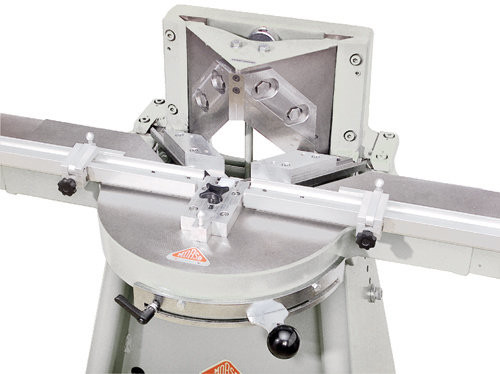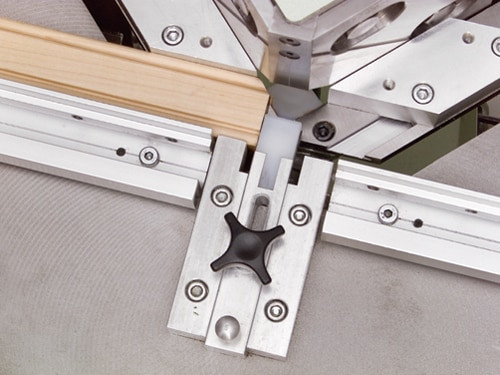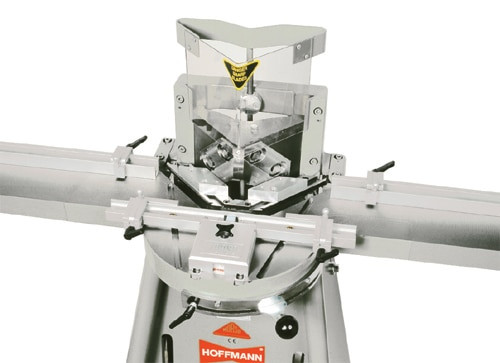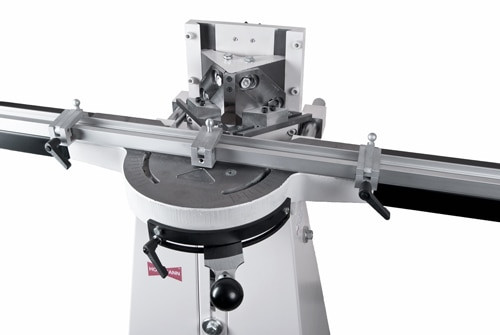Product Description
For centuries, the bead detail around the perimeter of a face frame has been used by craftsmen to decorate fine pieces of furniture. The delicate lines and carefully rounded edge add a subtle elegance to even the most utilitarian cabinets. Originated in the "Old World", the design quickly caught on and has always been found on traditional American furniture as well.
A cabinet with a beaded face frame immediately conveys a high level of quality and craftsmanship. Precisely machined joints and accurately fitted inset doors and drawers elevate even the simplest, single door design and distinctly set it apart from common overlay-door cabinets. Architects, Designers and Consumers have rediscovered this style and consequently, demand for beaded face-frame cabinets is on the rise.  Finished cherry kitchen with beaded face frames (by Foxcraft Cabinets, LLC)
Finished cherry kitchen with beaded face frames (by Foxcraft Cabinets, LLC)
Applying bead strips to square face frames
Up until now, the small to midsize custom cabinet shop owner has had few options when producing beaded face-frame cabinets, all of which have distinct disadvantages and draw-backs. The most common approach is the construction of face frames with square stock and to apply separate bead moulding. The major disadvantage is the time required to produce a completed frame. The square stock is ripped, squared and planed, then cut to length and assembled. Then the separate, small bead moulding needs to be ripped, planed and the edge rounded. This moulding is then miter-cut and fitted one by one into each opening, then glued and often fastened with brad nails. Afterwards, the nail holes are filled and sanded.

Time consuming task of applying bead strips individually
Aside from the time it takes to cut and fit every opening, other problems include mismatched grain and color on stain grade cabinets and mismatched miter joints due to inconsistent bead moulding. Another big concern is the potential for glue-joint separation between the square stock and the bead moulding.
Even small splits are especially obvious on painted cabinets and often require on-site touch-up and repair. The problem is amplified by door hinges mounted onto the beaded edge, which add stress exerted onto the glue joint. An unsatisfied customer or a call-back damages not only the cabinet shops reputation, but also its bottom line!
Clearly, the best way to produce beaded face frames is to start with beaded moulding. All of the above mentioned disadvantages such as hand fitting, color matching or glue joint separation are eliminated from the start.
 Beaded moulding - ready to be notched and assembled
Beaded moulding - ready to be notched and assembled
Different ways to cut notches in already beaded stock
Methods to use beaded moulding include marking and roughing out the notch on a bandsaw, then finishing up with a hand chisel, the use of a cross-cut sled on a tilting arbor table saw or using a custom cutter head used in a radial arm saw.
Marking and then cutting out notches with a bandsaw is the least efficient process and rarely seen in a professional setting (it may be suitable for a hobbyist building one piece of furniture).
After removing about 80% of stock with the saw, a hand chisel is used to carefully carve the final notch to size. This approach is neither fast, nor accurate and the chance for cutting the notch too wide or cutting the two corners at an angle other than exactly 45 degrees are too great.

Rough cutting a notch on a bandsaw
Using a sliding table saw is very time consuming and difficult, because the sawblade notch is easily and often cut too wide. In this case, a new stile needs to be made since there is no proper way to conceal to gaps in the finished joint. In addition, the saw blade doesn't leave a clean, finished edge and chisel work and hand fitting is required.

Cutting notches for beaded face-frames on sliding table saw
Using a radial arm saw with a special cutter head poses its own set of problems, the biggest of which is the fact that the width of the moulding determines the depth of the notch cut (the moulding is set on its edge, with the bead facing up). Even slight variations in width, or a slightly bowed stile, will result in an off-set or loose joint, which requires re-work.
Considering the concerns outlined with the above methods, it can agreed that for a professional woodworking shop to produce beaded face frames in an accurate and efficient manner, these requirements must be met:
1. The system must be designed to allow the woodworker to run long lengths of stock for stiles and rails through a moulder or shaper before starting the build face frames.
Adding a beaded strip to square face frames one piece at a time is not a solution and neither is cutting the bead detail after the notches are made.
2. The System must be designed to produce perfect joints every time, no matter what. This means the width of the notch must stay 100% constant and the two shoulders must remain at 45.0 degrees on every cut.
3. The System must allow quick changes for different notch widths while maintaining the cutting accuracy, no matter how small or wide the notches are cut. Tooling designed to lock in place, without the need to adjust or fine tune after every changeover, is essential for efficient production.

4. The System must be designed to produce perfect notches even after the cutting edges have been sharpened multiple times. Neither the width of the notch, nor the cutting angles of the shoulder can change due to sharpening procedures. The tooling must be designed to allow multiple sharpening cycles and long usable life in a production environment.
5. The System must be designed to allow the custom woodworker the use of different width moulding to meet his client’s demands. For example, a 5” wide bottom rail (toe kick) and a 6” wide top rail (to accept crown moulding trim) can be incorporated as single pieces without the need to glue-up wider parts after the frame is assembled.
(image of wide bottom rail joint)
6. The System must be able to accept different stock thicknesses because not every beaded face-frame is 3/4” thick. While most of them are, a large build-in bookshelf may call for 1” or even thicker face-frame stock to keep in proportion with the rest of the cabinet. Architectural woodwork applications include beams, wood ceiling designs, wine racks and many more.
(image of tall oak joint)
7. The System must be designed to allow for a wide range of bead sizes, from small 1/16” edge details on window mullions to deep 1/2” and wider bead profiles on large cabinets all the way to 1” deep notches when producing French-mitered cabinet doors.
(image of deep notch)
(image of French mitered door)
8. The System must use high-quality, precision build equipment of proven design and operation. Accuracy and reliability are of utmost importance.

MORSO face frame notching machines by Hoffmann meets all of the demands outlined above, they are the proven, accurate and reliable way to produce beaded face frames for custom shops as well as production facilities.
Please review the MORSO machine comparison page for details on each machine model and feel free to contact us with any questions. We have been the exclusive importer and distributor for MORSO notching machines for the US, Canada and Mexico for over 15 years and we look forward to help you select the machine model best suited for your needs.









